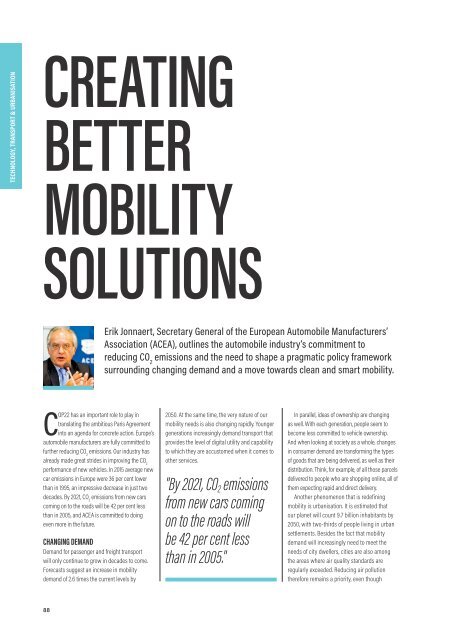Climate Action 2016-2017
Create successful ePaper yourself
Turn your PDF publications into a flip-book with our unique Google optimized e-Paper software.
TECHNOLOGY, TRANSPORT & URBANISATION<br />
CREATING<br />
BETTER<br />
MOBILITY<br />
SOLUTIONS<br />
Erik Jonnaert, Secretary General of the European Automobile Manufacturers’<br />
Association (ACEA), outlines the automobile industry’s commitment to<br />
reducing CO 2<br />
emissions and the need to shape a pragmatic policy framework<br />
surrounding changing demand and a move towards clean and smart mobility.<br />
COP22 has an important role to play in<br />
translating the ambitious Paris Agreement<br />
into an agenda for concrete action. Europe’s<br />
automobile manufacturers are fully committed to<br />
further reducing CO 2<br />
emissions. Our industry has<br />
already made great strides in improving the CO 2<br />
performance of new vehicles. In 2015 average new<br />
car emissions in Europe were 36 per cent lower<br />
than in 1995, an impressive decrease in just two<br />
decades. By 2021, CO 2<br />
emissions from new cars<br />
coming on to the roads will be 42 per cent less<br />
than in 2005, and ACEA is committed to doing<br />
even more in the future.<br />
CHANGING DEMAND<br />
Demand for passenger and freight transport<br />
will only continue to grow in decades to come.<br />
Forecasts suggest an increase in mobility<br />
demand of 2.6 times the current levels by<br />
2050. At the same time, the very nature of our<br />
mobility needs is also changing rapidly. Younger<br />
generations increasingly demand transport that<br />
provides the level of digital utility and capability<br />
to which they are accustomed when it comes to<br />
other services.<br />
"By 2021, CO 2 emissions<br />
from new cars coming<br />
on to the roads will<br />
be 42 per cent less<br />
than in 2005."<br />
In parallel, ideas of ownership are changing<br />
as well. With each generation, people seem to<br />
become less committed to vehicle ownership.<br />
And when looking at society as a whole, changes<br />
in consumer demand are transforming the types<br />
of goods that are being delivered, as well as their<br />
distribution. Think, for example, of all those parcels<br />
delivered to people who are shopping online, all of<br />
them expecting rapid and direct delivery.<br />
Another phenomenon that is redefining<br />
mobility is urbanisation. It is estimated that<br />
our planet will count 9.7 billion inhabitants by<br />
2050, with two-thirds of people living in urban<br />
settlements. Besides the fact that mobility<br />
demand will increasingly need to meet the<br />
needs of city dwellers, cities are also among<br />
the areas where air quality standards are<br />
regularly exceeded. Reducing air pollution<br />
therefore remains a priority, even though<br />
88












